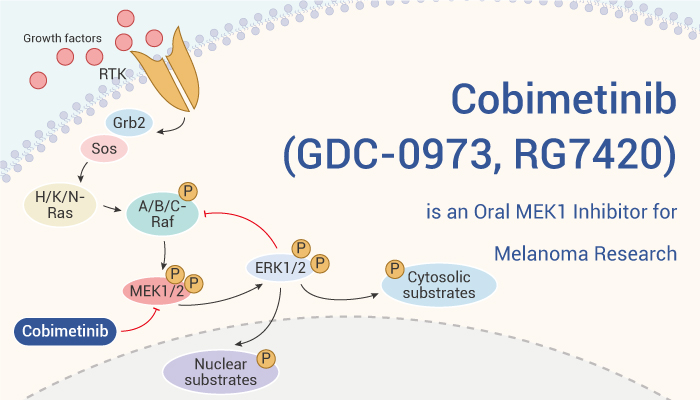MEK (Mitogen-activated protein kinase kinase, MAPKK) is a kinase enzyme that phosphorylates mitogen-activated protein kinases (MAPKs). Firstly, the activated MAPK leads to the phosphorylation of downstream transcription factors that regulate various responses such as stress signaling, pathogen response, and hormone signaling. In general, the MAPKKK phosphorylates a serine or threonine residue on a MAPKK, which sequentially activates a MAPK (ERK, p38 or JNK), the last protein in the cascade. Then, activation of the p38 MAPK occurs mainly through mitogen-activated protein kinase kinase 3 (MKK3) and MKK6 (sometimes MKK4). The highly homologous kinases, MEK1 and MEK2, act downstream of Ras and Raf to activate ERK mitogen-activated protein kinases.

Cobimetinib is an oral MEK1 inhibitor for melanoma research.
Cobimetinib (GDC-0973, RG7420) is a potent, selective, and oral MEK1 inhibitor with an IC50 of 4.2 nM for MEK1. The EC50 values of Cobimetinib (GDC-0973) for 888MEL and A2058 cells are 0.2 μM, and 10 μM, respectively. Melanoma cells are treated with EC50 concentration of MEK and PI3K inhibitors for 24 hours (888MEL: 0.05 μM GDC-0973, 2.5 μM GDC-0941; A2058: 2.5 μM GDC-0973, 2.5 μM GDC-0941). Mitochondrial OXPHOS limits cell death induced by cobimetinib (100 nM) in melanoma with constitutive MAPK activation in A375 cells.
In the NCI-H2122 KRASG12C mutant non-small cell lung carcinoma (NSCLC) xenograft model, treatment with up to 5 mg/kg Cobimetinib lead to moderate TGI and at 10 mg/kg approaches tumor stasis. GDC-0973 and GDC-0941 are administered to A2058 tumor-bearing mice daily (QD) or every third day (Q3D) either as single agents or in combination. The population rate constants associated with tumor growth inhibition for GDC-0973 and GDC-0941 are 0.00102 and 0000651 μM/h, respectively.
In conclusion, Cobimetinib is a potent, selective, orally available MEK1 inhibitor for cancer research.
[1] Klaus P Hoeflich, et al. Cancer Res. 2012 Jan 1;72(1):210-9.
[2] Edna F Choo, et al. Cancer Chemother Pharmacol. 2013 Jan;71(1):133-43.